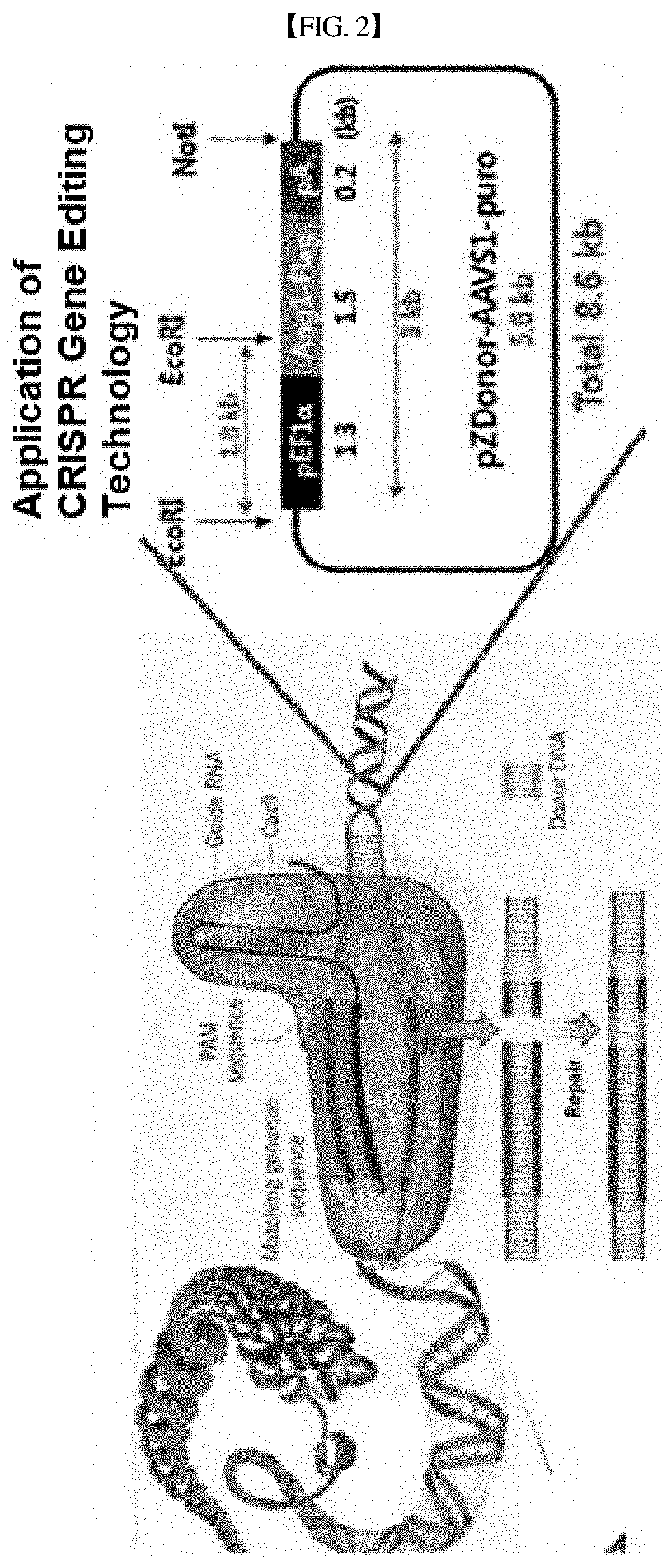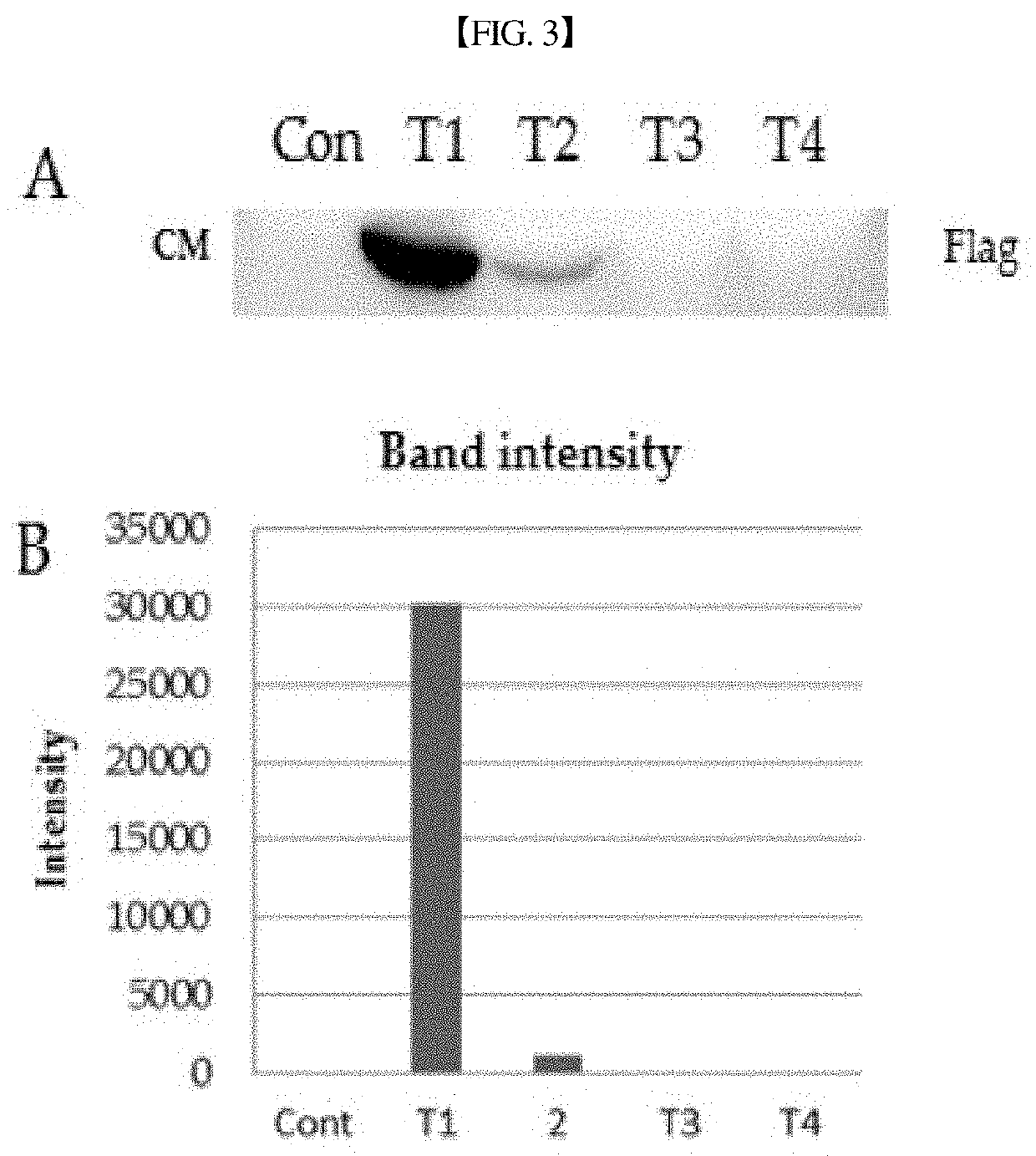Pharmaceutical composition for preventing or treating neurological disorders or cardiovascular diseases, comprising srage-secreting stem cell
- Summary
- Abstract
- Description
- Claims
- Application Information
AI Technical Summary
Benefits of technology
Problems solved by technology
Method used
Image
Examples
example 1
Characterization of sRAGE-Secreting UCB-MSCs
[0233]1-1. Construction of Donor sRAGE Vector
[0234]A sRAGE (cat. RD172116100, Biovendor; SEQ ID NO: 6) coding sequence (GenBank Accession No. NM_001206940.1) was prepared and incorporated into AAVS1 pZDonor vector (Sigma Aldrich; FIG. 1A). The vector is 5637 bp long, with HA-L and HA-R for homologous recombination established therein. Having sequences exactly identical to the AAVS1 site, the genes promote the natural repair system (homologous recombination). A homologous sequence insert may be incorporated into the chromosome of UCB-MSC in order to knock a specific gene sequence (sRAGE coding sequence) therein. The Multiple Cloning Sites (MCS) account for various restriction enzyme sites at which the sRAGE coding sequence is inserted into the AAVS1-pZDonor.
[0235]1-2. Preparation of Plasmid for Generation of sRAGE-Secreting UCB-MSCs
[0236]For use in generating sRAGE-secreting UCB-MSCs, an insert was composed of an EF1-alpha promoter, sRAGE c...
example 2
Neuroprotection and Movement Improvement Effect of sRAGE-Secreting UCB-MSC
[0246]2-1. Rotarod Test
[0247]To examine changes of the PD mice in the movement ability, a Rotarod test was performed (Reference Example 9.1). The results are depicted in FIG. 4. The average maintaining period of time was recorded as 65.54±10.73 seconds for control (normal mice), 29.30±13.48 seconds for PD mice (untreated), 47.65±17.68 seconds for sRAGE-treated PD mice, and 58.19±18.70 seconds for sRAGE-secreting UCB-MSC treated PD mice. As shown in FIG. 4, the movement ability was remarkably increased in both sRAGE-secreting UCB-MSC treated mice and sRAGE treated mice. Particularly, treatment with sRAGE-secreting UCB-MSC recovered the movement ability of PD mice to a similar level to normal mice.
[0248]2-2. Pole Test
[0249]Recovery of animal behavior was also measured by a pole test (Reference Example 9.2). The test results are shown in FIG. 5. The average maintaining periods of time were measured to be 5.00±1.2...
example 3
Mechanism of Protection Against Neuronal Cell Death
[0258]3-1. MAPK Pathway Assay—p38, Erk1 / 2, and JNK Proteins Contribute to Cell Death in MAPK Pathway
[0259]Changes of the main signaling pathway in the PD animal model were investigated at protein expression levels. To this end, tissues isolated from the CS region of PD mice were treated with AGE-albumin (50 nM) (AA) or AGE-albumin (50 nM)+sRAGE (50 nM), followed by western blotting analysis for the expression of proteins involved in the MAPK pathway (Reference Example 7). The result thus obtained is shown in FIG. 10. As shown in FIG. 10, JNK, p38, ERK1 / 2, and phosphorylated forms thereof were detected and expression levels of p38, Erk, and JNK were found to change. These results indicate that the three proteins (p38, Erk, and JNK) serve as contributors to neuronal cell death in PD mice, inducing neurodegeneration.
[0260]3-2. Bax Assay
[0261]Western blotting was performed to investigate the effect of sRAGE on the AGE-RAGE-dependent pat...
PUM
 Login to View More
Login to View More Abstract
Description
Claims
Application Information
 Login to View More
Login to View More - R&D
- Intellectual Property
- Life Sciences
- Materials
- Tech Scout
- Unparalleled Data Quality
- Higher Quality Content
- 60% Fewer Hallucinations
Browse by: Latest US Patents, China's latest patents, Technical Efficacy Thesaurus, Application Domain, Technology Topic, Popular Technical Reports.
© 2025 PatSnap. All rights reserved.Legal|Privacy policy|Modern Slavery Act Transparency Statement|Sitemap|About US| Contact US: help@patsnap.com



